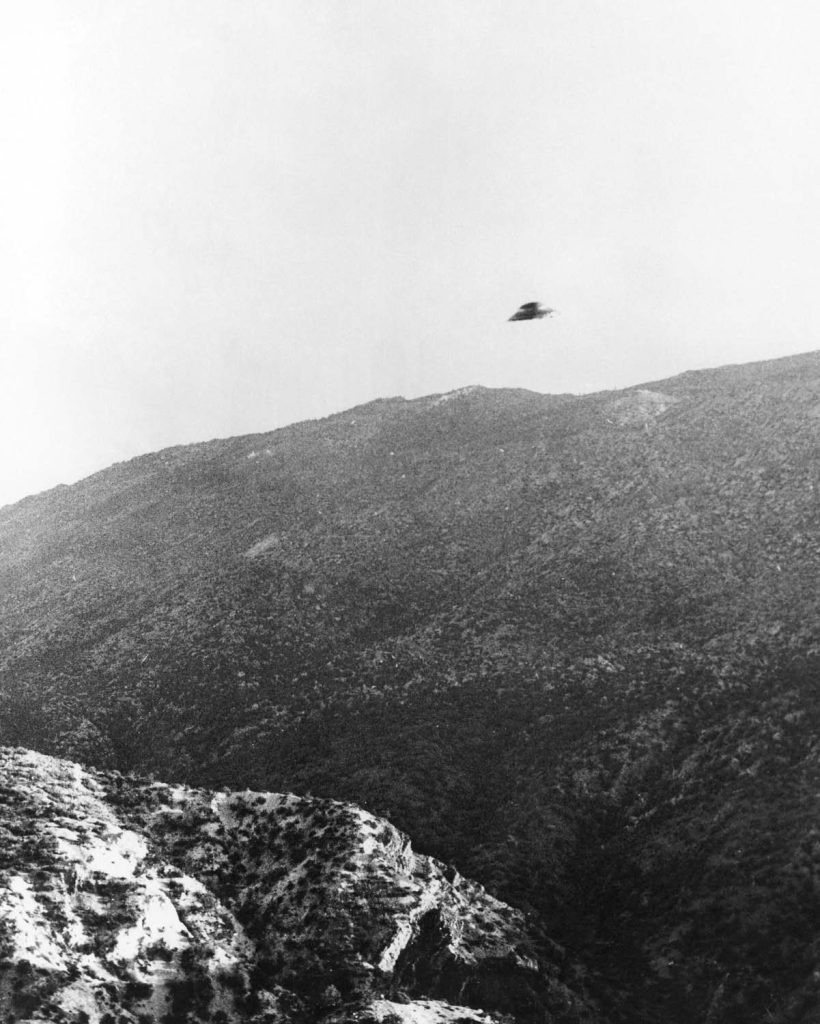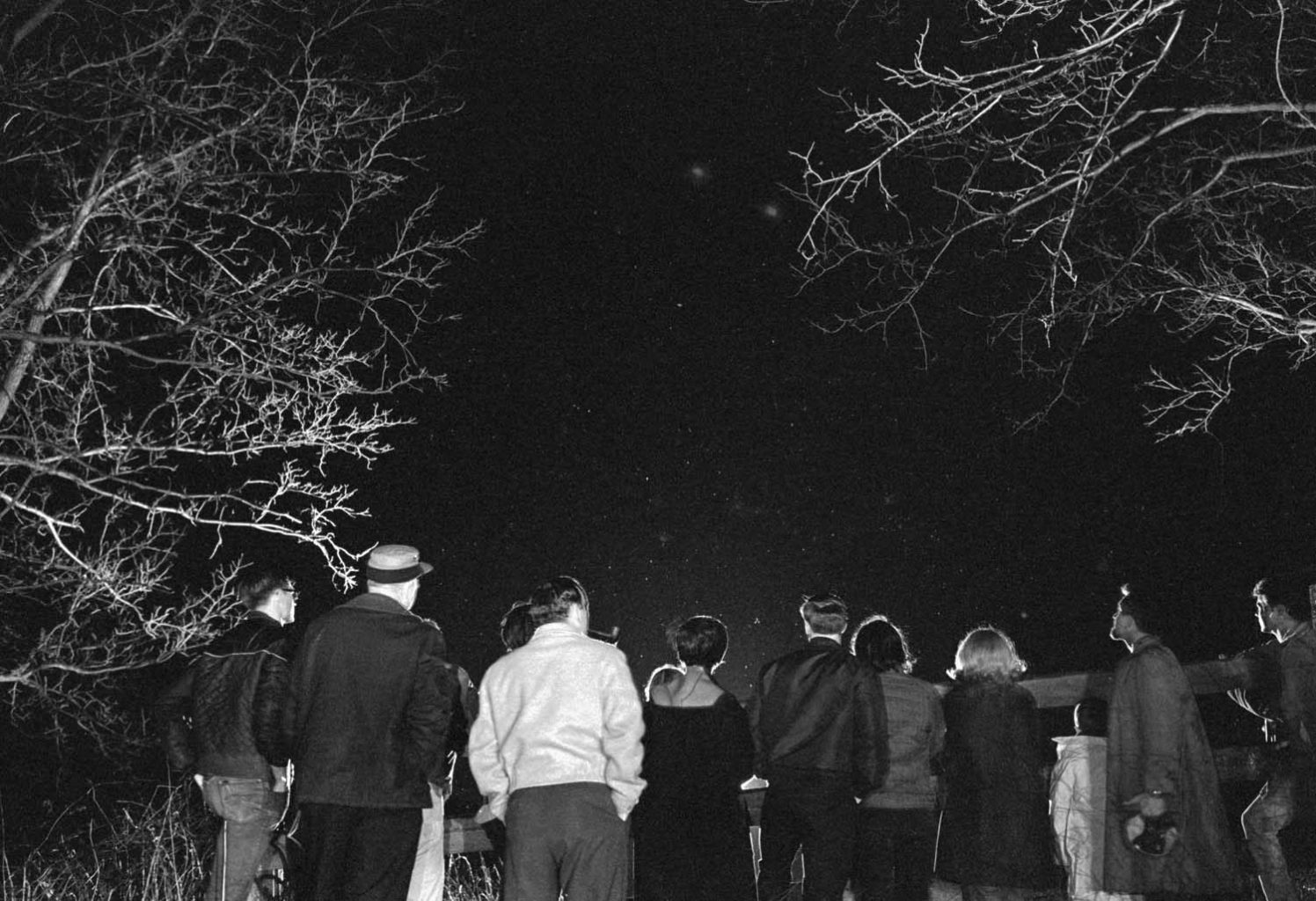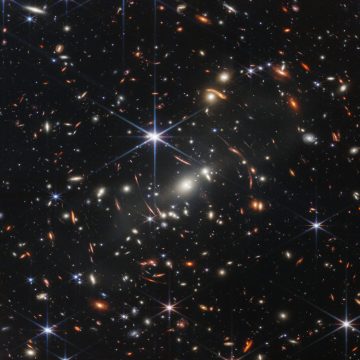Is there anybody out there?
Do aliens exist? What do they look like? Are they looking for us? How long until they find us? If you’ve ever looked into the night sky and thought it unlikely that our tiny planet, in our (relatively) tiny solar system, could possibly be the only place that supports life in the vastness of the universe… we know what you mean. And we’re not alone.

UFO photo and polaroid
Jim Shaw, 1977
In this series, photographer Jim Shaw observes how, in times of uncertainty and distrust in politics, we project our fears onto inexplicable phenomena such as observations of extraterrestrial life. “In the 1970s, when I was starting out, it was the era of the disaster film and of close encounters. It was like people wanted the end to happen because reality was so… boring.”
The Metropolitan Museum
An army of mysterious lights streaks across the desert sky. A single vast entity casts a chill shadow across a continent. An inhuman voice quacks out robotic commands over a million radios across the globe. Presidents and prime ministers are rooted to the spot in terror. Crowds, maddened by fear, flock to the streets, and survivalists take to the mountains. This, surely, is how the Earth will discover that we are not alone…
… Or perhaps not. Maybe, to the consternation of screenwriters and conspiracy theorists, life will appear not with glowing eyes and ray guns, but as a line on a graph. In September this year, Nikku Madhusudhan, Professor of Astrophysics and Exoplanetary Science, and his team became the first to detect carbon-based molecules in the atmosphere of K2-18 b, a habitable-zone exoplanet (a planet outside our solar system) just 120 light years away. Using observations from the James Webb Space Telescope, they analysed the light from K2-18 b’s parent star as it passed through the atmosphere of K2-18 b.

“From these observations, we can state very confidently that we have detected methane and carbon dioxide in this atmosphere,” says Madhusudhan. Methane and carbon dioxide without the presence of ammonia indicate the possibility of that cradle of life – an ocean. And there was another, more indistinct line on those graphs – what Madhusudhan carefully explains is “slight, tentative” evidence for the presence of the molecule dimethyl sulfide (DMS). “This is exciting, because DMS, on Earth, is produced exclusively by life. Much of the DMS in Earth’s atmosphere comes from oceanic micro-organisms. Molecules like this are known as secondary biomarkers. They are more robust signatures of life because they are very hard to make, geologically or naturally.”
The moment someone realises they can get their energy by eating someone else, the game changes. Everyone will have to adapt to the new world order
The next 10 years of observations will be crucial, Madhusudhan says, in establishing if DMS is indeed present – and, if it is, precisely what that means. In the meantime, we can only speculate about what form life outside the Earth might look like. And again, it might not be quite as outlandish as we think.
“There are constraints around evolution that determine what the nature of life is going to be like,” says Dr Arik Kershenbaum, Director of Studies at Girton and author of The Zoologist’s Guide to the Galaxy: What Animals on Earth Reveal About Aliens – and Ourselves. “As zoologists, we try to understand the evolutionary mechanisms that drive particular traits or particular ecosystems. And the more we understand them, the more we find that there is nothing special about Earth. These mechanisms are very fundamental. It’s very natural for a zoologist to think about how we could apply these rules to other places – whether that’s deep in the ocean, on an undiscovered island or on another planet.

Crices, New Mexico
Unknown, 1967
A student from New Mexico State University was hiking near Picacho Peak photographing land formations for a geology class when he spotted “a big round silvery object hovering in the air”. He said the object made no noise and disappeared as he looked down to change plates in the camera.
Associated Press / Alamy
Predation, says Kershenbaum, is a classic example, despite its origins being quite complicated. “Life has been eating other life for a very long time. But we do know that there came a point in Earth’s evolutionary history when predation became massively important – much more so than amoebas nibbling bits of algae. Suddenly, life was running around trying to catch other life and eat it, or running around trying to avoid being eaten. That is because a world where no one eats anyone else is unstable. The moment someone realises they can get their energy by eating someone else, the game changes. Everyone will have to adapt to the new world order. So if a world without predation is unstable, then we can expect life on other planets to have predation, because unstable systems do not persist indefinitely.”
Sadly, those predators are also unlikely to have characteristics that have no evolutionarily plausible pathway. Take the Xenomorph, star of six Alien films to date. It famously has a potent molecular acid in its blood, which can burn through pretty much anything remarkably quickly. (Though, interestingly, not the Xenomorph itself. Many theories exist as to why this is so.) “I love aliens and it’s fine for fiction to be fantastic,” says Kershenbaum. “And most fictional alien species are designed to have the properties that the author wants, without any consideration of why they should have those properties. Wouldn’t it be great for a whale to be able to fly? But there’s no actual pathway to that. There’s a constraint. There is no food in the air, so what’s the advantage of being able to fly? It doesn’t give you any advantage.”

McMinnville, Oregon
Paul Trent, 1950
Evelyn Trent was walking back to her farmhouse after feeding her rabbits when she noticed a slow-moving, metallic disc-shaped object heading in her direction from the northeast. She yelled for her husband, Paul, who managed to take two photos of the object before it sped away to the west.
Science History Images / Alamy
An advantageous trait, he points out, is likely to evolve multiple times from different origins – a theory known as convergence. And constraints, again, mean that there are only a few ways for that trait to develop. “Biology travels through history but ends up at much the same destination,” says Simon Conway Morris, Emeritus Professor of Evolutionary Paleobiology.
Compare, he says, the human eye and the octopus’s eye. Both evolved independently, from separate lineages – but both have a camera-type eye with one lens, as opposed to the compound eyes of insects, which are thousands of tiny light detectors packed together. “And that is very remarkable. One could argue that on any other planet there will be different sorts of eyes, as there are on this planet. But on the other hand, if you have a relatively large and intelligent life form, then it will almost certainly possess a camera eye. Convergent evolution on Earth gives us a good guide to any Earth-like planet and its life forms. What applies to this planet will broadly apply to any other planet.”

So, aliens might be fairly like us – or, at least, ‘us’ at some stage of our evolution, which could be anything from intelligent bipeds to green soup. Dr Emily Mitchell, Co-Director of the Leverhulme Centre for Life in the Universe, thinks that key to understanding extra-terrestrial life is understanding the evolution of life on Earth. By studying the origins of animals and what drove their early evolution, we can theorise about what we might find on similar planets, she says. “Life has existed on Earth for four billion years, but it was only around 600 million years ago that we start getting animals. Why? So, when we’re thinking about life outside the Earth, the question for me is: what level of complexity might we expect to find? Would we, on a similar planet of a similar age, expect to find humans, or not?”
Life, she points out, is a tricky thing to create. “Most of the time, life is just microbial, bacterial, very simple. If we look for life elsewhere, we may find it, but it’ll all be microbes. Perhaps we were lucky to evolve at all.”

Riverside, California
Guy B. Marquand Jr, 1951
Marquand claimed that the object above the skyline was a “flying saucer” that he and two friends saw fly past them at a very high speed. When it came back a few moments later, he had his camera ready to capture this photograph.
GRANGER / Alamy
But what about life on planets which don’t share Earth’s characteristics? “Much of astrobiology focuses on extremophiles and understanding how they live,” says Mitchell. “But lots of the extremophiles have a hugely long evolutionary history. Early life on another planet won’t necessarily have had the same time and the same evolutionary pressures to have evolved to that sort of level.
Plus, most life isn’t like that. If we’re looking for life elsewhere, we should be looking for things that we know work in a wide variety of different environments. By focusing on life as we know it now, we’re not excluding the extremophiles but we’re capitalising on a way of life that we know works.”
Thus far, if there is something out there, it has remained resolutely silent. What are our chances of finding anything? “If you accept that life itself is something that automatically evolves, and if you subscribe to the general ideas of convergent evolution, then there should be lots of planets with intelligent bipeds. Aliens should exist,” says Conway Morris. “I don’t think they do – but I am keeping an open mind.”

Dexter, Michigan
Unknown, 1966
Hundreds of curious citizens turn out to scan the night sky after reports of UFOs frequenting the skies of Dexter in southern Michigan, USA.
Bettmann / Getty
Kershenbaum believes that the evidence would imply life. “The Earth formed 4.5 billion years ago and cooled enough to have liquid water more than four billion years ago. Life evolved 3.8 billion years ago. That’s almost instantaneous, relatively speaking. You can’t statistically conclude anything from that, but it implies that the origin of life from non-life isn’t ridiculously improbable.”
And Mitchell agrees. “Because of the diversity of exoplanets we have and the huge number of them, the circumstances that led to life on Earth probably would happen again and happen repeatedly. But whether we get animal levels of complexity – that I’m not sure of. I’d expect to find a lot of life elsewhere, but probably microbial life.”
And Madhusudhan? “I get asked about life elsewhere in the universe a lot, and it’s a very risky question,” he says. Three decades ago, he points out, we didn’t know of any planet outside the solar system at all. Today, we know that almost every star should have at least one planet around it. “That’s a sea-change in our perspective of the universe. The scientific side of me says that we must be sceptical about every stage of the process. But if I follow natural logic, life appears to be the logical conclusion.” What that life might look like, of course, remains to be seen. Keep watching the skies.







